
Salmon is the common name for several commercially important species of euryhaline ray-finned fish from the genera Salmo and Oncorhynchus of the family Salmonidae, native to tributaries of the North Atlantic (Salmo) and North Pacific (Oncorhynchus) basins. Other closely related fish in the same family include trout, char, grayling, whitefish, lenok and taimen, all coldwater fish of the subarctic and cooler temperate regions with some sporadic endorheic populations in Central Asia.

Salmonidae is a family of ray-finned fish that constitutes the only currently extant family in the order Salmoniformes, consisting of 11 extant genera and over 200 species collectively known as "salmonids" or "salmonoids". The family includes salmon, trout, char, graylings, freshwater whitefishes, taimens and lenoks, all coldwater mid-level predatory fish that inhabit the subarctic and cool temperate waters of the Northern Hemisphere. The Atlantic salmon, whose Latin name became that of its genus Salmo, is also the eponym of the family and order names.

The megamouth shark is a species of deepwater shark. Rarely seen by humans, it measures around 5.2 m (17 ft) long and is the smallest of the three extant filter-feeding sharks alongside the relatively larger whale shark and basking shark. Since its discovery in 1976, fewer than 100 specimens have been observed or caught. Like the other two planktivorous sharks, it swims with its mouth wide open, filtering water for plankton and jellyfish. It is recognizable from its large head with rubbery lips. The megamouth is so unlike any other type of shark that it is usually considered to be the sole extant species in the family Megachasmidae, though some scientists have suggested it may belong in the family Cetorhinidae.

Otodus megalodon, commonly known as megalodon, is an extinct species of giant mackerel shark that lived approximately 23 to 3.6 million years ago (Mya), from the Early Miocene to the Pliocene epochs. O. megalodon was formerly thought to be a member of the family Lamnidae and a close relative of the great white shark, but has been reclassified into the extinct family Otodontidae, which diverged from the great white shark during the Early Cretaceous.
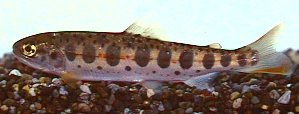
The masu salmon, also known as masu or cherry trout in Japan, is a species of salmonid belonging to the genus Oncorhynchus, found in the North Pacific along Northeast/East Asian coasts from the Russian Far East to south through Korea, Japan and Taiwan. Although generally accepted as a salmon in the West, the fish is actually regarded as a trout in Japan as it is the most commonly seen freshwater salmonid in the Japanese archipelago.
Sabretooth or sabertooth may refer to:
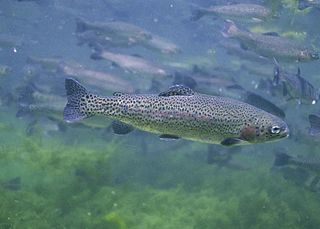
The rainbow trout is a species of trout native to cold-water tributaries of the Pacific Ocean in Asia and North America. The steelhead is an anadromous (sea-run) form of the coastal rainbow trout(O. m. irideus) or Columbia River redband trout (O. m. gairdneri) that usually returns to freshwater to spawn after living two to three years in the ocean. Freshwater forms that have been introduced into the Great Lakes and migrate into tributaries to spawn are also called steelhead.

The chum salmon, also known as dog salmon or keta salmon, is a species of anadromous salmonid fish from the genus Oncorhynchus native to the coastal rivers of the North Pacific and the Beringian Arctic, and is often marketed under the trade name silverbrite salmon in North America. The English name "chum salmon" comes from the Chinook Jargon term tzum, meaning "spotted" or "marked"; while keta in the scientific name comes from Russian, which in turn comes from the Evenki language of Eastern Siberia. The term 'Dog Salmon' is most commonly used in Alaska and refers to the Salmon whose flesh Alaskans use to feed their dogs.

The Chinook salmon is the largest and most valuable species of Pacific salmon. Its common name is derived from the Chinookan peoples. Other vernacular names for the species include king salmon, Quinnat salmon, Tsumen, spring salmon, chrome hog, Blackmouth, and Tyee salmon. The scientific species name is based on the Russian common name chavycha (чавыча).

Pink salmon or humpback salmon is a species of euryhaline ray-finned fish in the family Salmonidae. It is the type species of the genus Oncorhynchus, and is the smallest and most abundant of the seven officially recognized species of salmon. The species' scientific name is based on the Russian common name for this species gorbúša (горбуша), which literally means humpie.

The coho salmon is a species of anadromous fish in the salmon family and one of the five Pacific salmon species. Coho salmon are also known as silver salmon or "silvers". The scientific species name is based on the Russian common name kizhuch (кижуч).

Oncorhynchus is a genus of ray-finned fish in the subfamily Salmoninae of the family Salmonidae, native to coldwater tributaries of the North Pacific basin. The genus contains twelve extant species, namely six species of Pacific salmon and six species of Pacific trout, all of which are migratory mid-level predatory fish that display natal homing and semelparity.
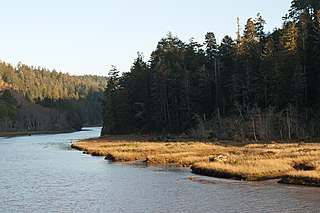
The Big River is a 41.7-mile-long (67.1 km) river in Mendocino County, California, that flows from the northern California Coast Range to the Pacific Ocean at Mendocino, Mendocino County, California. From the mouth, brackish waters extend 8 miles (13 km) upstream, forming the longest undeveloped estuary in the state.

The Biwa trout is an anadromous salmonid fish of the genus Oncorhynchus, endemic to Lake Biwa in Shiga Prefecture, Japan, but also introduced to Lake Ashi and Lake Chūzenji. While called trout, the fish is most closely related to the masu salmon of the western Pacific Ocean, and is most often considered a subspecies of it, Oncorhynchus masou rhodurus.
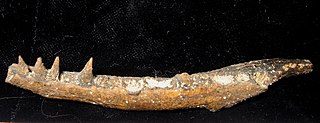
Oncorhynchus lacustris is an extinct species of prehistoric freshwater trout from the late Miocene to late Pliocene of Western North America. Its fossils have been found in lacustrine deposits in what is now Idaho.
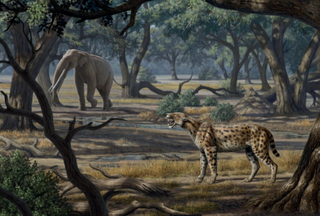
Lokotunjailurus is an extinct genus of saber-toothed cats (Machairodontinae) which existed during the late Miocene and earliest Pliocene epoch and is known from localities in northern, central, eastern and southern Africa. A big cat, it was more slender than comparable recent species and its build suggests cursoriality. It is grouped among a group of similar-looking saber-toothed cats known as the scimitar-tooths.
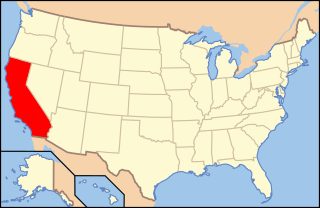
Paleontology in California refers to paleontologist research occurring within or conducted by people from the U.S. state of California. California contains rocks of almost every age from the Precambrian to the Recent.
The Pinole Tuff Formation is a geologic formation of the East Bay region of the San Francisco Bay Area in California.
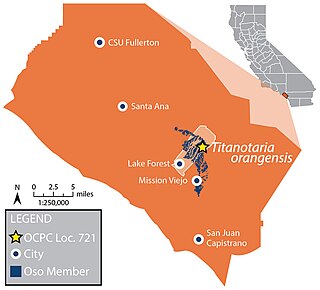
The Capistrano Formation is a geologic formation in coastal southern Orange County, California. It preserves fossils dating back to the late Miocene to early Pliocene, with the Oso Member representing a near-shore environment. Fifty-nine species and varieties of foraminifera are recognized from the Capistrano Formation alongside a diverse array of marine mammals including up to five species of walrus.

A kype is a hook-like secondary sex characteristic which develops at the distal tip of the lower jaw in some male salmonids prior to the spawning season. The structure usually develops in the weeks prior to, and during, migration to the spawning grounds. In addition to the development of the kype, a large depression forms in the two halves of the premaxilla in the upper jaw, allowing the kype to fit into the premaxilla when the mouth is closed.




















